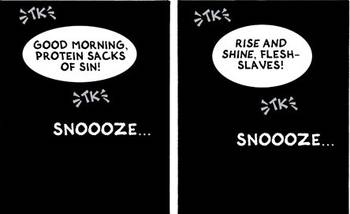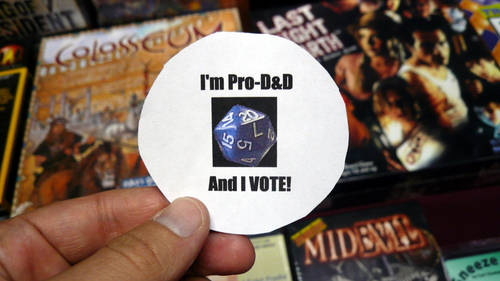The Latest from Boing Boing |  |
- Unscientific look into MIT students' sex-lives
- New York's small-town kangaroo courts: hives of abusive unchecked authority
- JK Rowling didn't plagiarise Adrian Jacobs
- Warren Ellis alarm clock
- Roger Ebert rages against takedowns of his Siskel tribute
- Writers describe the positive impact of D&D on their lives
- Swarm of tiny illuminated helicopters as flying display screen?
- Babies With Laser Eyes
- Open-source environmental protection
- Quite possibly the greatest segment in the history of Antiques Roadshow
- Images of Madness
- Funky Friday: Orchestre Poly-Rythmo de Cotonou, circa 1970
- Survey on connectivity and food
- Howtoons Visual Communication guide
- Everything in a pizza pocket, the poster
- Awesome, whole-house "mousetrap" contraption
- Butch cupcakes for men
- The Dawning of the Age of Biology
- Miniboss T-shirt in the Boing Boing Bazaar
- Disney goes goth
- Maywa Denki performance tomorrow in LA
- Disney's Fast Play is the slow way to the DVD feature
- I Warned You to Stay Away From My Stuff
- 2010 Nebula Nominees
- URL redirection service makes innocent URLs look sinister
- What we can learn from Nepali orphans
- Could This Really Happen to You?
- Centenary of First Ever Air to Ground Radio Message: "Come and Get this Goddam Cat"
- Fractal zoomer
- School district admits installing covert webcam activation software on student laptops, denies wrongdoing
| Unscientific look into MIT students' sex-lives Posted: 20 Feb 2010 12:11 AM PST  MIT's The Tech has the results of a wide-ranging survey of the sex-lives of the university's undergraduates. It's not very scientific (the respondents were self-selected, and 60% of the student body didn't respond), but the charts and commentary are a fun read. I'm particularly taked by the idea of a taboo against "floorcest" (shagging someone whose room is on the same dorm floor as yours). MIT's The Tech has the results of a wide-ranging survey of the sex-lives of the university's undergraduates. It's not very scientific (the respondents were self-selected, and 60% of the student body didn't respond), but the charts and commentary are a fun read. I'm particularly taked by the idea of a taboo against "floorcest" (shagging someone whose room is on the same dorm floor as yours). Sex@MIT: The Survey (via MeFi) Previously:
|
| New York's small-town kangaroo courts: hives of abusive unchecked authority Posted: 20 Feb 2010 12:05 AM PST The New York Times has an excellent investigative piece on the small-town judges of New York State. These judges are elected to office, need no legal training, have no oversight (many don't even keep court records), and have the power to imprison people for up to two years (and some accused have been kept in jail for many more years, waiting for a judge to call their cases), and collect millions in (unaudited) fines and penalties. The system is a shambles, and there have been calls for reform since the 1920s, with no movement to do anything about it, despite racist remarks, blatant violations of law, pursuit of personal vendettas from the bench and other grave misconduct. Judges send abused women back to their spouses ("Every woman needs a good pounding every now and then," quipped Donald R. Roberts, a former state trooper, now a judge in Malone, NY), lock up children, deny accused counsel, find accused guilty without a trial or a plea. Reading this piece, you get the sense that the reporters struggled to winnow down the list of horrific abuses to fit the space -- the litany of absolutely nightmarish judicial behavior goes on and on and on and on. In Tiny Courts of N.Y., Abuses of Law and Power Previously:
|
| JK Rowling didn't plagiarise Adrian Jacobs Posted: 19 Feb 2010 11:48 PM PST Teresa Nielsen Hayden expertly dissects the latest accusation of plagiarism against JK Rowling, and imparts rather a lot about the publishing industry in the bargain.
|
| Posted: 19 Feb 2010 11:43 PM PST  Wednesday's Dork Tower comic contemplated the possibility of a Warren Ellis alarm clock. I'd buy one, or at least download one for my Android phone! Wednesday's Dork Tower comic contemplated the possibility of a Warren Ellis alarm clock. I'd buy one, or at least download one for my Android phone! DORK TOWER, Wednesday, February 17, 2010 (via Forbidden Planet) Previously:
|
| Roger Ebert rages against takedowns of his Siskel tribute Posted: 19 Feb 2010 11:39 PM PST Hal sez, "Near the end of his long and touching Esquire article about the career and illness of Roger Ebert, Chris Jones writes about Ebert's discovery that somebody (probably Disney) had disappeared the YouTube videos of his tribute to Gene Siskel on his own freaking show:" Roger Ebert: The Essential Man (Thanks, Hal!) |
| Writers describe the positive impact of D&D on their lives Posted: 19 Feb 2010 11:29 PM PST Matt sez, "With that rocks-for-brains reporter in Boston trying to link campus shooter Amy Bishop's crimes to Dungeons & Dragons, I thought I'd take an opportunity to look at the good D&D has done for several writers I know. This is that article. By the way, I've been a D&D player for almost thirty years now, and have been a happier, more productive person for it." I haven't played since my early 20s (late teens?) but D&D was an enormously positive influence on my life and imagination. Writers reminisce about Dungeons & Dragons (Thanks, Matt!) Previously: |
| Swarm of tiny illuminated helicopters as flying display screen? Posted: 19 Feb 2010 09:17 PM PST MIT researchers are exploring whether a swarm of tiny helicopters outfitted with LEDs could self-organize into a massive flying display "screen." The vision for the nascent Flyfire project is that each of the choppers acts as a pixel to form a dynamically-reconfigurable display.  From MIT's SENSEable City Lab, co-developers of the Flyrire project: With the self-stabilizing and precise controlling technology from the ARES Lab, the motion of the pixels is adaptable in real time. The Flyfire canvas can transform itself from one shape to another or morph a two-dimensional photographic image into an articulated shape. The pixels are physically engaged in transitioning images from one state to another, which allows the Flyfire canvas to demonstrate a spatially animated viewing experience.Flyfire |
| Posted: 19 Feb 2010 02:33 PM PST  babieswithlasereyes.com, via Dangerous Minds (thanks, Tara McGinley). |
| Open-source environmental protection Posted: 19 Feb 2010 02:17 PM PST What do you think the Environmental Protection Agency needs to be paying attention to? How should they make data more transparent? Who could they collaborate with? Now you can take your ideas to the people who matter. As part of the Agency's Open Government plan, they're soliciting input from the public through March 19th. Not only can you offer ideas, you can vote, and comment, on other people's. |
| Quite possibly the greatest segment in the history of Antiques Roadshow Posted: 19 Feb 2010 02:00 PM PST Garth Johnson of Extreme Craft has extensive coverage about this wheeled and squeaking toy pig being appraised on Antiques Roadshow. I agree with Jesse Thorn that this segment is quite possibly the greatest segment in the history of Antiques Roadshow. A rather smug gentleman shows off his rare "animated" pull pig toy. The fellow doesn't get his comeuppance, though. His confidence in the awesomeness of his pig toy is rewarded by a $2000-$2500 appraisal for his $200 investment.Animated Pig Pull Toy |
| Posted: 19 Feb 2010 01:55 PM PST  Rogier van der Weyden: The Last Judgment (large size image here), 1446-52. From this livejournal treasure trove of historical engravings and prints depicting people who have totally lost it. (Thanks, Miss Calpernia!) |
| Funky Friday: Orchestre Poly-Rythmo de Cotonou, circa 1970 Posted: 19 Feb 2010 01:52 PM PST Orchestre Poly-Rythmo de Cotonou Dahomey - Gbeti Madjro (Analog Africa)
Previously:
|
| Survey on connectivity and food Posted: 19 Feb 2010 01:27 PM PST Jeremy sez, "Shareable.net and the consultancy Latitude are co-launching a study to understand how new connectivity--improved accessibility, transparency, organization, and socialization of information--alters our desires and decisions around food and food-purchasing. The study will remain open for participation for 1-2 weeks, and results will be posted to Shareable and life-connected.com by mid-March. And when the study reaches 50 participants, we will donate $500 to The Hunger Project, a global non-profit committed to the sustainable end of world hunger." |
| Howtoons Visual Communication guide Posted: 19 Feb 2010 03:04 PM PST  Former Boing Boing guest blogger and Howtoons co-creator Saul Griffith says: We just finished a huge project in collaboration with Lemelson-MIT InvenTeams - Seeing the Future: A Visual Communication Guide - which is a 20 drawing/inventing guide that teaches kids/adults how to get those big ideas down on paper. Please pass it along; we would love this to get to as many kids (and big kids) as possible.About the guide | Seeing the Future! the Howtoons Visual Communication guide | PDF version |
| Everything in a pizza pocket, the poster Posted: 19 Feb 2010 12:58 PM PST  Justin Perricone sez, "This is a poster I designed using all of the ingredients in a Ham & Cheese Hot Pocket. First in a series." Hot Pockets Ingredients (Thanks, Justin!) Previously:
|
| Awesome, whole-house "mousetrap" contraption Posted: 19 Feb 2010 12:04 PM PST This whole-house "mousetrap" contraption proves that opening the curtains in the least efficient way possible is often also the most awesome way possible. Best part of the video: The cellphone call. |
| Posted: 19 Feb 2010 02:06 PM PST  NYC's Butch Bakery (founded by a lawyer) makes "manly cupcakes" like the B-52, shown here, "not a frilly pink-frosted sprinkles and unicorns kind of cupcake." These baked goods have become so popular that the company has suspended telephone orders. NYC's Butch Bakery (founded by a lawyer) makes "manly cupcakes" like the B-52, shown here, "not a frilly pink-frosted sprinkles and unicorns kind of cupcake." These baked goods have become so popular that the company has suspended telephone orders. Butch Bakery (via Sociological Images) Update: Pipenta's got my vote for comment of the year, for #20, below, which opens "Why stop here? They aren't even making the shift from red velvet to black leather cupcakes! These aren't nearly butch enough! What about shaving stubble cream filling? Pigskin, jockstrap, cigar butt cupcakes. At the very least, there should be a Guinness option, a beer belly cupcake. Wasabi might be too dainty, but kimchee and a hot chili icing option would be on the money." It gets ruder and better from there. Previously: |
| The Dawning of the Age of Biology Posted: 19 Feb 2010 06:43 PM PST  Some people whose names you may know or computers you may have used all had dinner together last week. Photo above: Apocalyptic shit-disturber John Cusack eats the final grape at the namedrop alpha table, drawing heated commentary from Microsoft Chairman Bill Gates, who sources say did not get a single grape. (L-R, for reals, EDGE 2010 dinner: Jared Cohen, US State Department; Dave Morin, Facebook; John Cusack, actor/writer/director/thinker; Dean Kamen, Inventor, Deka Research; Bill Gates, Microsoft, Gates Foundation; Arianna Huffington, The Huffington Post; Michael Shermer, Skeptic Magazine. Not shown in this photo, but huddled around the same table, were Peter Diamandis, George Church, and me. )
Here's the photo gallery for this dinner, hosted by John Brockman and EDGE to herald "the Dawing of the Age of Biology." Let the jpeg record show that I managed to get up close and personal with Marissa Mayer and Nathan Wolfe, then later with Danny Hillis. More about the big ideas discussed, after the jump. John Brockman, in presenting the theme for this 2010 edition of the annual EDGE dinner, wrote:
All the scientists mentioned above by Dyson (with the exception of Simonyi) were present at the dinner. Others guests who are playing "a significant role in this new age of wonder through their scientific research, enlightened philanthropy, and entrepreneurial initiative" included Larry Brilliant, George Church, Bill Gates, Danny Hillis, Nathan Myhrvold, Jeff Skoll, and Nathan Wolfe. EDGE: "The Edge Dinner: A New Age of Wonder, Where the Dawning of the Age of Biology Was Officially Announced." (Thank you, John Brockman / EDGE.org) |
| Miniboss T-shirt in the Boing Boing Bazaar Posted: 19 Feb 2010 11:31 AM PST  Seibei, based in Poughkeepsie, NY, is selling these handsome MINIBOSS shirts in the Boing Boing Bazaar. Sizes range from ladies small to unisex XXX large. Previously featured items from the Boing Boing Bazaar: |
| Posted: 19 Feb 2010 11:12 AM PST Disney's launching a line of girl-goth merch to tie in with the release of Alice in Wonderland, whose soundtrack features Cure frontman Robert Smith performing a track from the 1951 Alice movie: "Walt Disney Co.'s consumer-products division is aiming its marketing firepower at young women and teenage girls, particularly those who gravitate to darkly romantic entertainment like the 'Twilight' series." (Thanks, @keithabramson!) |
| Maywa Denki performance tomorrow in LA Posted: 19 Feb 2010 09:39 AM PST If you're in LA tomorrow, don't miss Otomatone inventor Maywa Denki's rare US performance at the Giant Robot store in Sawtelle. Details here. |
| Disney's Fast Play is the slow way to the DVD feature Posted: 19 Feb 2010 09:26 AM PST Bill Bumgarner had the same experience as I did with Disney's Fast Play option on DVDs. I watched Sleeping Beauty with my daughter last week and was tricked by choosing Fast Play. How could anyone not be irritated by this stupid anti-feature? We received Chicken Little from Netflix today and I noticed that it features "Disney's Fast Play Technology." When inserted, you get the choice between "Fast Play" and "Main Menu.'Disney's Fast Play (Or Marketing of a Flipped Bit) |
| I Warned You to Stay Away From My Stuff Posted: 19 Feb 2010 09:40 AM PST  Thanks to the tireless efforts of a legion of Chinese engineers/joke-fabricators, it's now possible to a own a Dwight Schrute-like office cubicle where every single item in sight, from the stapler to the desk clock to the computer mouse to the can of soda, is engineered to provide a hysterically comical high voltage shock when touched. Thanks to the tireless efforts of a legion of Chinese engineers/joke-fabricators, it's now possible to a own a Dwight Schrute-like office cubicle where every single item in sight, from the stapler to the desk clock to the computer mouse to the can of soda, is engineered to provide a hysterically comical high voltage shock when touched. Who would want to do that? Man, that would be so cool; who wouldn't? I added up the total price for all items listed below and the whole bill comes somewhere around $50. Partial listing of Shocking Gag Devices available at just one online merchant and no doubt I'm just scratching the surface of the entire shocking gag gift industry: Shocking gag lighter So maybe I'll do that. Or would that would just be immature? |
| Posted: 19 Feb 2010 08:43 AM PST Good looking Nebula Awards ballot this year! Congrats to all the nominees -- this is as fine a reading list as you're apt to find. Start with the novels: The Windup Girl by Paolo Bacigalupi, The Love We Share Without Knowing by Christopher Barzak, Flesh and Fire by Laura Anne Gilman, The City & The City by China Miéville, Boneshaker by Cherie Priest, and Finch by Jeff VanderMeer. |
| URL redirection service makes innocent URLs look sinister Posted: 19 Feb 2010 08:40 AM PST  ShadyURL: "Don't just shorten your URL, make it suspicious and frightening." The shady URL for ShadyURL is http://5z8.info/--INITIATE-CREDIT-CARD-XFER--_r8a4a_dogfights (Via Neatorama) |
| What we can learn from Nepali orphans Posted: 18 Feb 2010 05:23 PM PST Materially, the kids at Ama Ghar have little beyond bare necessities. Their toys are soccer balls made of rubber bands and old car tires. In the mornings they wash their hair and brush their teeth at a cold water tap outdoors, and after school they play with their half-exploded imitation Mizuno volleyball near the neighbor's pigsty until the sun goes down. Most nights, they do their homework under a single solar-powered backup lightbulb because of scheduled electrical outages, before going to sleep in tiny rooms crammed with second-hand bunk beds. The most surprising thing about these kids, though, is not their living conditions. It's their attitude. These are really good kids. Generally speaking, they don't cheat, steal, complain, sneak off, or flake on their chores. During an eight-hour field trip to a Hindu temple on the other side of the Valley, the children kept tabs on each other without being told to do so, waiting patiently for the adults as they bargained for potatoes on the side of the street. Not one child complained about being hungry or needing to use the bathroom. Like a tight-knit family, they hugged each other often and shared everything without selfishness. The children all studied hard at school, like their lives depended on it — probably because their lives really do depend on it. As Bonnie Ellison, the resident manager, told me: "It's not easy out there." Hers is the epitome of tough love; an American who herself grew up in Kathmandu, she is arming them with the skills and attitude they need to survive and thrive in Nepali society. I left Ama Ghar with the strong conviction that these spirited, bilingual, ambitious kids could very well shape the future of this beautiful, struggling nation.
On my way home to San Francisco, I stopped through Tokyo to visit my parents. They were moving out of the property our family lived on for 22 years and had a lot of furniture they needed to get rid of. My mother was delighted when a nearby orphanage agreed to take the fridge and kitchen cabinet as donations. We made plans to visit the home and meet the director, who offered to give us a short tour.
|
| Could This Really Happen to You? Posted: 19 Feb 2010 07:55 AM PST  As a contributing editor at Make Magazine, I know how important a good magazine cover is for single copy sales. A pretty girl is good for sales, and a guy dissecting a house plant is not so good. As a contributing editor at Make Magazine, I know how important a good magazine cover is for single copy sales. A pretty girl is good for sales, and a guy dissecting a house plant is not so good. This is my favorite cover of all time - it has it all. (But I just can't imagine how the scenario depicted could possibly take place. Maybe these people are models on a photo shoot gone bad, or maybe this is the top floor of a parking garage.) Sure made me want to buy the mag. So I went on eBay and bought it. |
| Centenary of First Ever Air to Ground Radio Message: "Come and Get this Goddam Cat" Posted: 19 Feb 2010 07:18 AM PST 2010 marks the centenary of a number of great events, including the first air to ground radio message. Exactly 100 years ago, a gray tabby named Kiddo became the first cat to cross the Atlantic Ocean by dirigible. Kiddo belonged to one of the crew members of American explorer Walter Wellman's airship America. In 1910 Wellman attempted to cross the ocean, leaving from Atlantic City, New Jersey on 15 October that year. More information on this momentous event is here. |
| Posted: 19 Feb 2010 06:31 AM PST  Guy sez, "This is my fractal generator and zoomer. The basic premise is I wrote a php program which will generate a fractal based on parameters passed to it and return it as an image to the browser. By calling this program with specific parameters a fractal can be generated that can be zoomed in on infinitely. The other link is a demonstration of the relationships between the Mandelbrot and Julia Set versions of the fractals. If you view the Mandelbrot fractal and then tile the Julia version you will begin to see the outline of the Mandelbrot version in the tiled Julia. This has been a lot of fun to write, I would love to take it a bit further and write some explanations and teaching tools. Please keep in mind that all the images are generated on the fly so if you do post this my server may go BOING!" Guy sez, "This is my fractal generator and zoomer. The basic premise is I wrote a php program which will generate a fractal based on parameters passed to it and return it as an image to the browser. By calling this program with specific parameters a fractal can be generated that can be zoomed in on infinitely. The other link is a demonstration of the relationships between the Mandelbrot and Julia Set versions of the fractals. If you view the Mandelbrot fractal and then tile the Julia version you will begin to see the outline of the Mandelbrot version in the tiled Julia. This has been a lot of fun to write, I would love to take it a bit further and write some explanations and teaching tools. Please keep in mind that all the images are generated on the fly so if you do post this my server may go BOING!" Welcome to the Fractal Generator (Thanks, Guy!) Previously:
|
| Posted: 19 Feb 2010 06:16 AM PST  The Superintendant of the Lower Merion School District -- where parents have initiated a class action suit over the covert use of students' laptops to surveil them in school and at home -- has sent a letter to parents with more information about the spying. The school admits that there was spyware installed on students laptops that allowed for remote, covert activation of their webcams, but maintains that the measure was only to be used in the event of theft of the machine (some had speculated that the school was only able to surveil students' hard drives, and that the images of a student engaged in "misconduct" in his home that a vice-principal confronted the student with had been taken by the student, intentionally, and stored on the laptop's hard-drive, from which it was retrieved by the school administration -- this now seems not to have been the case). The school also claims that the system can only capture still images, not audio or video. They have disabled the system for now and deny that it was misused. The Superintendant of the Lower Merion School District -- where parents have initiated a class action suit over the covert use of students' laptops to surveil them in school and at home -- has sent a letter to parents with more information about the spying. The school admits that there was spyware installed on students laptops that allowed for remote, covert activation of their webcams, but maintains that the measure was only to be used in the event of theft of the machine (some had speculated that the school was only able to surveil students' hard drives, and that the images of a student engaged in "misconduct" in his home that a vice-principal confronted the student with had been taken by the student, intentionally, and stored on the laptop's hard-drive, from which it was retrieved by the school administration -- this now seems not to have been the case). The school also claims that the system can only capture still images, not audio or video. They have disabled the system for now and deny that it was misused. As a result of our preliminary review of security procedures today, I directed the following actions:School Sued For Spying On Students With Laptop Cameras Says It Was A Security Feature, Turns It Off (Thanks, Dan!) (Image: IMG_6395, a Creative Commons Attribution-ShareAlike image from bionicteaching's photostream) |
| You are subscribed to email updates from Boing Boing To stop receiving these emails, you may unsubscribe now. | Email delivery powered by Google |
| Google Inc., 20 West Kinzie, Chicago IL USA 60610 | |

 And several people in the small town of Dannemora were intimidated by their longtime justice, Thomas R. Buckley, a phone-company repairman who cursed at defendants and jailed them without bail or a trial, state disciplinary officials found. Feuding with a neighbor over her dog's running loose, he threatened to jail her and ordered the dog killed...
And several people in the small town of Dannemora were intimidated by their longtime justice, Thomas R. Buckley, a phone-company repairman who cursed at defendants and jailed them without bail or a trial, state disciplinary officials found. Feuding with a neighbor over her dog's running loose, he threatened to jail her and ordered the dog killed...  1. The plaintiffs haven't paid much attention to other works in the genre.
1. The plaintiffs haven't paid much attention to other works in the genre.  Ebert keeps scrolling down. Below his journal he had embedded video of his first show alone, the balcony seat empty across the aisle. It was a tribute, in three parts. He wants to watch them now, because he wants to remember, but at the bottom of the page there are only three big black squares. In the middle of the squares, white type reads: "Content deleted. This video is no longer available because it has been deleted." Ebert leans into the screen, trying to figure out what's happened. He looks across at Chaz. The top half of his face turns red, and his eyes well up again, but this time, it's not sadness surfacing. He's shaking. It's anger.
Ebert keeps scrolling down. Below his journal he had embedded video of his first show alone, the balcony seat empty across the aisle. It was a tribute, in three parts. He wants to watch them now, because he wants to remember, but at the bottom of the page there are only three big black squares. In the middle of the squares, white type reads: "Content deleted. This video is no longer available because it has been deleted." Ebert leans into the screen, trying to figure out what's happened. He looks across at Chaz. The top half of his face turns red, and his eyes well up again, but this time, it's not sadness surfacing. He's shaking. It's anger. 

 As regular readers of this blog know, I
As regular readers of this blog know, I 
No comments:
Post a Comment